Lucky Quarantine Day 13! Well, President Fernandez did not make an announcement as expected yesterday to extend the quarantine period from this coming Tuesday night, the 31st, to the 13th… which would be Day 5 of Passover and/or Easter Monday. It doesn’t mean he still won’t, he’s had a habit during the few months so far of his administration of waiting until last minute to make important announcements. Gives things the air of having truly and seriously been considered in depth and with great gravitas. It’s also a pain in the backside for anyone to prepare for anything, as most things he announces go into effect a few hours after he announces them. We shall see. I think it’s probably a good idea that they do extend it, but no one in the administration is asking my opinion.
Today, the promised (from Instagram feed…) Peruvian version of liver and onions – higado encebollado. It’s a chifa dish, i.e., from the Peruvian and Chinese fusion cooking that’s come to be over the last century, and in many ways is kind of like a version of Chinese pepper steak, just with liver. In fact, it’s not all that different from how I would make lomo saltado, which is the Peruvian Chinese version of pepper steak.
What do we need? We need the liver, obviously – beef liver here, about a pound of it, cut into “steaks” of about 2-3 ounces each. About a tablespoon of chopped garlic, and a couple of tablespoons of pisco (Peruvian brandy, basically, and if you don’t have pisco, brandy would be a fine substiute). A couple of chopped onions, julienned bell pepper and tomatoes (about 2:1:1 in volume), and a pureed re-hydrated aji panca and aji mirasol, the red and yellow dried peppers of Peruvian cooking. And, some chopped cilantro and parsley. Classically, you’d also have about a ¼ cup of soy sauce here, but Henry doesn’t like the dish made with it, so I left it out.
Marinate the liver steaks in the pisco, garlic, and some salt (maybe half a teaspoon) for about an hour.
Remove from marinade, pat dry, and fry in hot oil…
…until just browned on both sides. You don’t need to cook them through at this point. Remove them to a plate and set aside.
Deglaze the pan, i.e., add some liquid and quickly scrape all the bits and crispiness and flavor that’s stuck to various parts of the pan. Easiest thing here is simply use the marinade that remains in the bowl you marinated the liver in – I mean, pisco, garlic… what’s not to like? Add the onions. Now, here’s where two different thoughts seem to diverge.
There are those who go towards the Chinese side of the chifa fusion and treat this like a quick wok stir-fry, just tossing and barely softening the vegetables over very high heat, leaving them still somewhat crisp but hot. They would also likely, have treated the liver differently and either cooked it through, so that the onion saute could just be spooned over it, or they’d slice the liver into bite size pieces so that they’d cook through faster in the final moments of the stir-fry.
And then there are those that go to the Peruvian side and reduce the heat down to a medium, and cook them until you get that soft, slightly caramelized character. Guess which way I went?
If you guessed the latter, you’re right. I cooked the onions for about ten minutes, then added the chili paste…
…and cooked that down for about another two minutes.
Then I added the peppers, and about another five minutes.
Gets them nice and softened, and the onions are really starting to caramelize now.
Add the tomatoes, and at this point, I cover the pan, turn the heat down low, and leave it for about ten minutes. If you’re using the soy sauce, this is the point to add that too. The tomatoes start to break down…
…add the liver pieces back in, along with whatever juices have drained off of them onto the plate, it’s just going to enrich the dish. Nestle them in well, cover the pan, and let them cook until done. We like the liver to be around medium – still slightly pink in the middle, that’ll take about six or seven minutes, turning the livers once in the middle of that to cook evenly. If you like the liver more well done, let it go to about ten minutes.
[This is the point where if you were doing the Chinese leaning version, you’d toss in those bite sized pieces of liver and finish cooking them – also all of the above timings would be like one minute each rather than extended cooking.]
Toss well with the chopped cilantro and parsley, check the seasoning – if you’ve used soy sauce, you probably won’t need any salt, if you haven’t, as we haven’t, you’ll probably add some salt. Oh, and a decent sprinkling of freshly ground pepper too. Then…
Serve it up. The classic accompaniment for higado encebollado is white rice and boiled potatoes. I put a slight twist on the latter, I cut thick slices of the potato and boil them in salted water for about five minutes, just to let them absorb some water and start to cook. Then I put them in a single layer in a baking dish, lightly coated with olive oil and sprinkled with salt, and put them into a really hot oven for about ten minutes, then flip them over and back in for another ten. They come out lightly crispy on the outside and soft and fluffy inside.
And, that’s today’s recipe from our Buenos Aires quarantine….
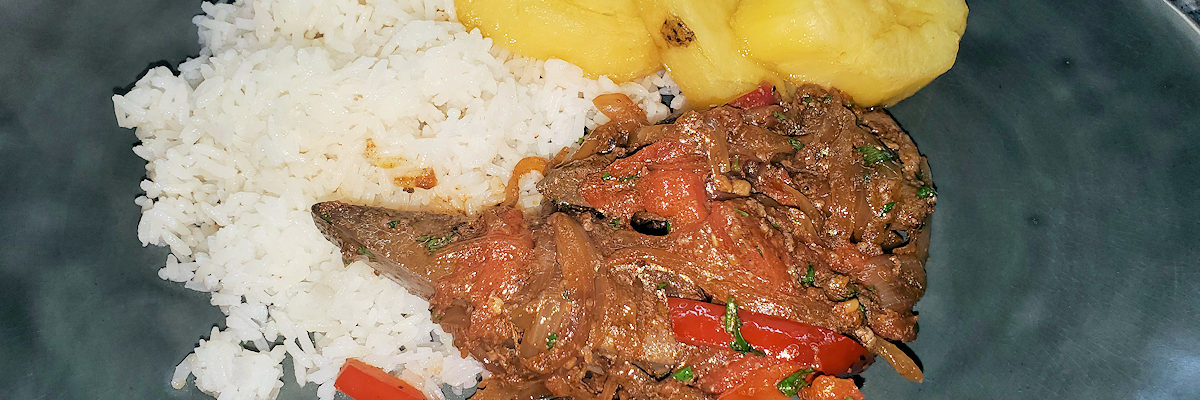
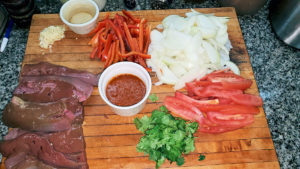
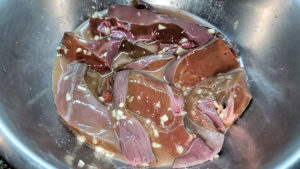
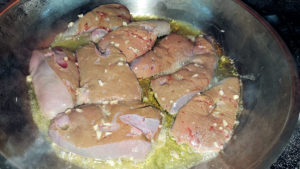
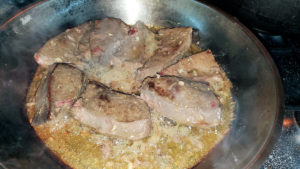
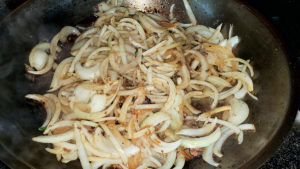
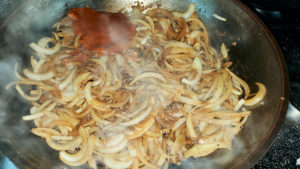
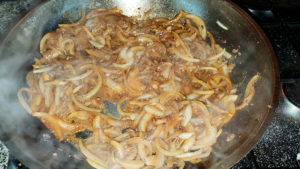
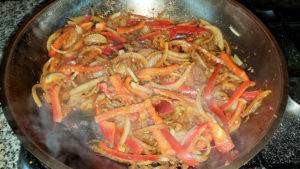
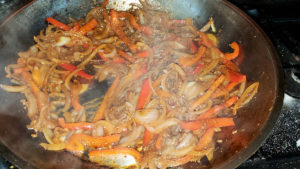
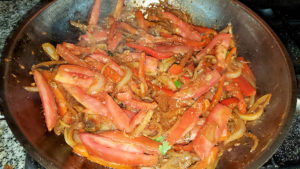
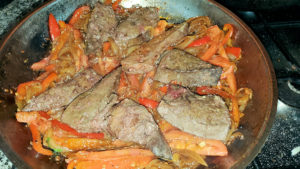
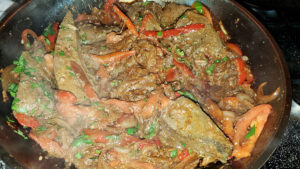
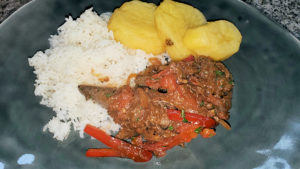
Note: Tried a different recipe for this one that I may even like better. Left out the bell pepper and the cilantro. Replaced the pisco with red wine vinegar and soy sauce (Henry didn’t know I used it this time, and he liked it too). And, marinated the liver in a mix of the pureed chilies, garlic, vinegar, soy, salt, pepper, and added in some ground cumin, overnight. The tang of the vinegar and the longer marinating really lifted the dish up – maybe keep the pisco in too and just give it more complexity next time. I did kind of miss the bell pepper, which just add another texture and more color to the dish.